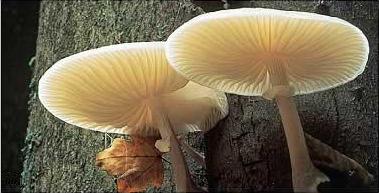Fungi, nature's recyclers
Interview with
So we've heard how bacteria can play a role in environmental clean ups, but what  about nature's recyclers, fungi?
about nature's recyclers, fungi?
Geoff Gadd from the University of Dundee works on this question.
Geoff - We've been working on various systems and we've been particularly interested in lead and uranium in some separate studies. In fact, we've found that in both cases, fungi are capable of mediating the formation of lead-containing minerals or uranium containing minerals. They're actually some kinds of phosphates. In fact, it was very interesting with the lead because the mineral formed was a lead phosphate called pyromorphite. Now, this is a mineral and it's actually the most stable lead mineral that's found in the Earth's crust and was commonly advocated as a remediation technique for lead contaminated land. Phosphate sources such as apatite or bone meal would be added and this would immobilise the phosphate. But we've shown that the actual organisms themselves can actually form the pyromorphite in the soil and it could be just a case of encouraging the fungal populations to grow up a bit to do this.
Kat - So basically, lock it away in a form that it can't leech out and contaminate the wider environment.
Geoff - That's the idea and it's actually the same with uranium. They made a uranium phosphate mineral and funnily enough, the uranium phosphate mineral was actually more stable than the depleted uranium that was being attacked by the organism. So, this might be one good approach where the metals are locked up in an insoluble form and then hopefully, they don't leeched out and find their way into water or get taken up by plants and the like.
Kat - Where are you looking for these wonderful metal converting fungi in the world?
Geoff - Well, funnily enough, you can really get organisms everywhere that can do these kind of tricks, but I will say that we did find some special fungi over in old lead polluted mine sites in the southwest of Scotland, actually near a place called lead hills. We found that some organisms isolated from there were the ones that had this capacity to transform lead into this mineral. So, in some cases, there might be a connection between some kind of special organisms and a kind of polluted location where they've adapted or they've been selected because of this property. They can also help them by removing the lead toxicity.
Kat - And thinking about how you might try and take these fungi that you've found say, in Scotland and take them to other sites that are contaminated, would your idea be that you kind of grow them up in the lab and then ship them out? Or are there other ways that you could maybe encourage the naturally occurring fungi there already?
Geoff - Addition of organisms is one possibility although that's often done for some kind of organic breakdown. But in actual fact, it's best to use the indigenous populations perhaps by encouraging them. Some of these things are widely found properties in many species, in fact, just the additional of fertiliser basically just the same way as you might put manure on your garden to encourage plants to grow - the same approach, providing carbon and nitrogen to enable fungal populations to grow might work. In fact, this has been shown over in the US some time ago with cases of selenium pollution where the organisms were encouraged to grow by addition of such materials and remove of selenium pollution.
Kat - So you're basically just giving mother nature a little kind of a nudge in the right direction.
Geoff - Exactly.
Kat - So, do you feel that the future is fungal or do you think we're just going to have to use as many different cleanup methods as possible to try and decontaminate our environment?
Geoff - I think there's possibilities in all contexts. I mean, bacteria have a fantastic metabolic capability and so, they're applicable to a whole kind of situations. Fungi are perhaps are a bit more limited in the kinds of environmental places they can be, but there's still a wide range of possibilities. And of course, we mustn't forget that in a polluted site, especially polluted soil, both bacteria and fungi are together. In fact, it's been shown that both bacteria and fungi have to work together to treat some of the more complex aromatic organic pollutants for example. So, everything is possible.
- Previous The Longitude Prize
- Next Managing oil spills with bacteria










Comments
Add a comment